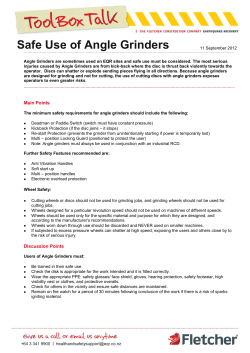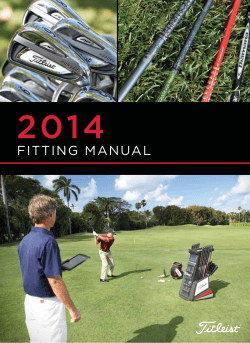
surefit tour introduction
surefit tour introduction STEP 1. READ INSTRUCTIONS BEFORE USE ™ To avoid damaging the threads of the SureFit Tour system, the shaft and wrench should always be in alignment when the head is loosened or tightened. The screw should engage smoothly without binding. If the screw feels tight or difficult to turn, stop the assembly process and start over. Forcing the screw will strip the threads. If you experience difficulty: • Explore titleist.com for video tutorials • Contact your Titleist Area Sales Manager INCORRECT STEP 2. HOW TO USE THE SUREFIT TOUR WRENCH The SureFit Tour wrench must always be in straight alignment with the shaft to properly engage and tighten the screw. USE WRENCH TAB TO ENGAGE SCREW WITH LIGHT FORCE LIGHTLY ENGAGE SCREW TIGHTEN SCREW FORCEFULLY UNTIL THE WRENCH “CLICKS” TIGHTEN UNTIL “CLICK” STEP 3. HOLD THE CLUB STRAIGHT-UP The club should be held straight-up with the end of the grip resting on the ground for support. HOLD CLUB STRAIGHT-UP WITH THE END OF THE GRIP ON THE GROUND CORRECT CLUB AND WRENCH ARE ANGLED AND NOT IN ALIGNMENT INCORRECT STEP 4. LOOSEN THE CLUBHEAD Step 1. Position the shaft and wrench in straight alignment with the head positioned up-ward and the end of the grip resting on the ground. Carefully insert the tip of the wrench into the silver, star-shaped screw located in the hosel of the club until the tip sits firmly against the bottom of the shaft. Step 2. Turn the SureFit Tour wrench counter-clockwise (4) full turns until the screw loosens just enough to allow the ring to rotate freely on the sleeve. FOR EASY ADJUSTMENT, DO NOT FULLY REMOVE THE SCREW FROM THE SHAFT. LOOSEN THE SCREW ONLY (4) FULL TURNS STEP 5. ADJUST THE SUREFIT™ TOUR HOSEL The SureFit Tour hosel features a sleeve and ring, each with four settings. The sleeve settings are numbered 1, 2, 3, 4, and the ring settings are lettered A, B, C, D. There are 16 combinations which each create a unique loft and lie angle for your club. Step 1. Use the 910 Performance Guide to determine which setting optimises your ball flight. Step 2. Align the sleeve and ring to the desired setting with the dot on the back of the hosel. With the wrench and shaft in straight alignment, tighten the head until the wrench “clicks”. Step 3. Hit balls at the new setting and observe flight. Repeat steps 2 and 3 above as desired to achieve your preferred flight. STEP 6. TIGHTEN UNTIL THE WRENCH “CLICKS” After adjustment, the clubhead must be tightened securely with the SureFit Tour wrench before it can be safely used for play. Step 1. Position the shaft and wrench in straight alignment with the clubhead up and the end of the grip resting on the ground. Then, carefully insert the SureFit wrench tip into the hosel screw. Step 2. With the sleeve, ring, shaft and wrench in straight alignment, tighten the screw forcefully with the SureFit Tour wrench until you feel, and/or hear the wrench “click”, indicating that the proper torque has been applied. The screw should go in smoothly. If the screw feels like it is binding, stop and re-align the components before tightening. Do not under-tighten. Step 3. Before play, inspect the club to ensure that the sleeve, ring and head components fit together tightly and securely. TIGHTEN THE SCREW UNTIL THE WRENCH “CLICKS”, INDICATING THAT THE PROPER TORQUE HAS BEEN APPLIED. fit for optimal launch and spin 910 Metals feature SureFit Tour, which allows the loft and lie of each club to be independently adjusted and set for increased distance and control. The following pages outline how SureFit Tour settings are used to more precisely fit golfers. All Titleist metals are built in the A•1 position (RH). CLOSED CLOSED OPEN OPEN *LOFT = EFFECTIVE LOFT with a square face at impact. The 910 SureFit Tour grid shows the resulting loft when the face is squared at impact— sometimes referred to as “effective loft”. Notes on face angle nGolfers will react differently to changes in face angle. nSome will square the face at impact and alter the loft. • The head will have more loft when squared at impact if you start with a closed face angle. • The head will have less loft when squared at impact if you start with an open face angle. nSome will maintain the club's static face angle and the resulting change in face angle will affect direction. • A closed face angle will result in left ball flight. • An open face angle will result in right ball flight. nSome golfers will make a combination of these adjustments. nThe golfer's ability to consistently return the club face at impact has a greater effect on directional control than the face angle setting. nUltimately, the golfer's ball flight will be your best source of guidance regarding performance. using the surefit tour grid nTo increase launch angle and spin, move up from the current setting on the SureFit Grid. nTo decrease launch angle and spin, move down from the current setting on the SureFit Grid. Right Hand surefit grid CLOSED CLOSED OPEN OPEN left Hand surefit grid Fitting for lie angle The proper lie angle for the player can be determined by evaluating the side angle and curvature of the ball flight. The SureFit Tour hosel provides four different lie angles for each loft position. 1.Starting with the driver set in the A•1 position, have the player hit shots with the driver model and shaft selected earlier in the fitting. nReference the Lie Angle Dispersion chart and adjust accordingly to maximize accuracy and preferred ball flight. 2.Observe the ball flight and adjust accordingly. 3.Hit balls at the new setting and observe the ball flight. Repeat steps 2 and 3 as desired to achieve your preferred flight. 4.Ask the player if they have a lie angle preference, while the club sits at address. 5.Consider the player’s preferred lie angle as well as their ideal ball flight. Using the SureFit Grid nTo flight the ball more to the right, move to the right from the current setting. nTo flight the ball more to the left, move to the left from the current setting (See example below) nRemember that the player’s ability to consistently deliver the club has a greater effect on directional control than lie angle. Example for fitting lie angle A fitter has determined that a 910D2 9.5° at the A•1 setting produces good launch, but ball flight left of the target. The fitter makes the lie angle 0.75° flatter by changing the setting from A•1 to B•1. This reduces the left ball flight and results in shots closer to the intended target. lie angle Notes Robot driver testing shows that a 0.75° lie angle change (one column change of the SureFit grid setting) moves ball flight two yards down range. Many players will experience a greater difference in ball flight. fitting FOR loft Launch angle can be visually identified during the first half of ball flight. Spin can be visually identified during the second half of ball flight. imaginary launch w i n d ow 1 . to o h i g h ideal 2 . to o l ow General guidelines for ideal launch angle launch angle Too High Above 14° Ideal 9° to 14° Too Low Below 9° LAUNCH CONDITION NOTES 1.A ball that launches too high or rises too quickly because of excess backspin will “balloon” up and above the optimum launch window. 2.A ball that launches too low or does not have enough backspin will “drop” below the optimum launch window. 3.R&D Robot testing has found that for every 0.75° change in loft (one row of change of the SureFit setting), launch angle changes by 0.5° and spin changes by 275 rpm. 4.For fitters using Trackman, appropriate launch and spin will usually result in a landing angle less than 40°. 5.As ball speed increases, spin rate becomes a more important factor in driver flight. 6.As ball speed decreases, launch angle becomes a more important factor in driver flight. Fitting for loft The proper loft can be determined by evaluating both launch and spin as the player hits shots. The SureFit Tour Hosel provides four different loft settings for each head and enables a very precise fitting. FITTING FOR LOFT Finding the proper loft can help optimize the player's launch angle, while generating the correct spin to allow the player to maximize their overall distance. 1.Start with the standard loft and previously selected lie angle and have the player hit multiple shots with a pre-selected driver model and shaft. n Reference the tables as well as the Driver Performance Charts 2.Observe the ball flight and adjust loft accordingly. 3.Hit balls at the new setting and observe the ball flight. Repeat steps 2 and 3 as desired to achieve your preferred flight. example for FITTING LOFT (RH) A fitter has determined that a 910D2 9.5° with the Titleist Mitsubishi Kai'li is the correct model and shaft for the player, but the ball flight is launching too low. The fitter increases the loft 0.75° by changing the setting from A•1 to D•4. This increases the launch angle and results in better trajectory and carry distance. CLOSED CLOSED OPEN OPEN *LOFT = EFFECTIVE LOFT with a square face at impact. www.titleist.co.uk
© Copyright 2025



















